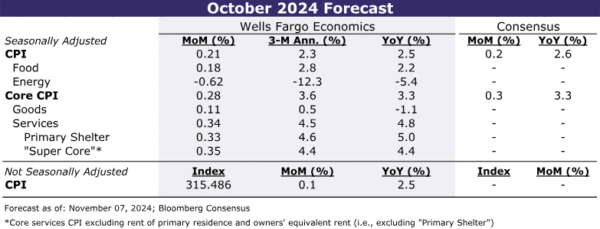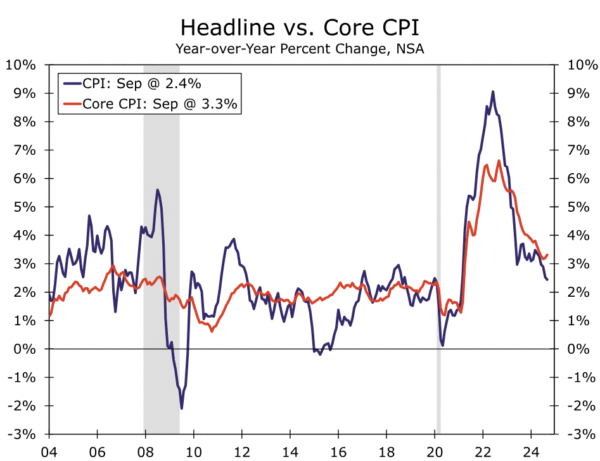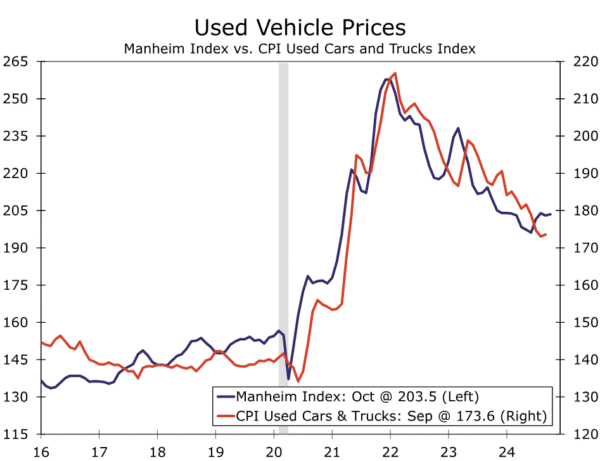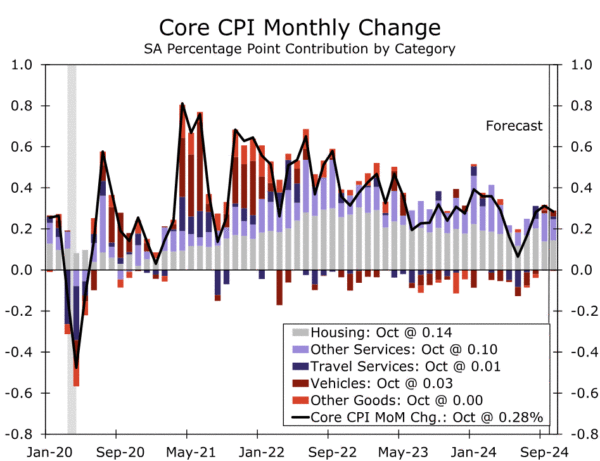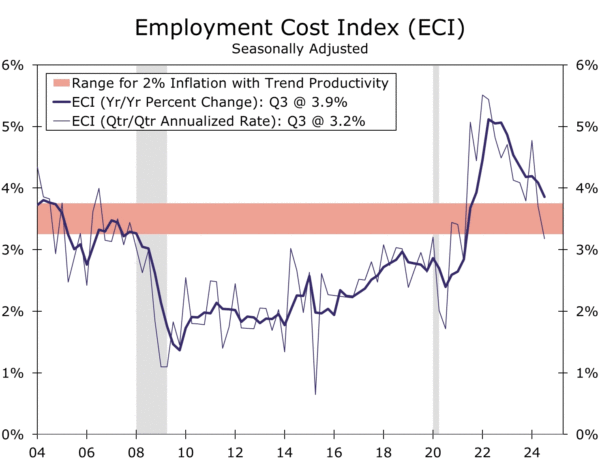Summary
The October Consumer Price Index will likely show that progress in wringing out the last bit of inflation remains frustratingly slow. We look for headline CPI to have advanced 0.2% in October, which would bump up the 12-month change in consumer prices to 2.5%. Excluding food and energy, prices are likely to have increased 0.3% for a third consecutive month as another increase in goods prices coincides with glacial easing in services inflation.
Glacial Slowing in Services and Firmer Goods Prices Bode Poorly for Overall Inflation Progress
The October CPI report will likely support the notion that the last mile of inflation’s journey back to target will be the hardest. We look for the Consumer Price Index to have advanced 0.2% (0.21% unrounded) in October, causing the year-over-year rate to edge back up to 2.5% from 2.4% last month (Figure 1). Excluding food and energy, a third consecutive 0.3% monthly increase is expected to keep the core index up 3.3% year-over-year—still about one percentage point higher than its pre-pandemic pace.
A more temperate gain in food prices likely helped to keep October’s headline gain in check. After grocery prices leapt 0.4% in September, we expect a slower rise in October (0.1%). About one-third of September’s increase in food at home could be traced to eggs, but wholesale prices have eased in recent weeks, pointing to some giveback from September’s hot reading. Amid a trend-like 0.3% rise in food away from home, we estimate the 12-month change in overall food inflation edged back down to 2.2%. Further offering consumers some reprieve was the continued easing of gas prices last month. We estimate energy goods prices fell roughly 1.4% in October and 13% from this time last year. However, the downdraft to overall inflation from energy is waning, and the risks to energy costs, at least for the time being, lie to the upside given geopolitical tensions in the Middle East.
Glacial Slowing in Services Keeping Inflation On
Excluding the more volatile energy and food components, the unwinding of pandemic-era price distortions has proven to be frustratingly slow. Our expectation for a 0.28% monthly gain would push the three-month annualized rate of core CPI up to 3.6% while keeping the 12-month rate at 3.3% for a second straight month.
Core goods prices look set for another rise in October, although it will likely be more modest (0.1% compared to 0.2% September) with a different set of drivers. After some of the largest gains of the past year in categories like apparel, household furnishings and other goods, we expect some mean-reversion in non-vehicle core goods. In contrast, the recent rebound in auction prices for used cars point to what could be the largest monthly gain in the CPI for used vehicles in about a year (Figure 2). We still think that the benefits of smoother supply chains and cooler demand have yet to fully run their course, but the deflationary impulses from new and used cars in particular may ebb through the final months of the year—especially as the devastation of Hurricanes Helene and Milton boosts demand for replacement vehicles and parts.
Having increased 4.8% in the year through September, services categories remain the real laggard in terms of core inflation settling back down (Figure 3). We look for a 0.34% rise in services ex-food and energy, which would be essentially unchanged from the prior monthly gain of 0.36%. Primary shelter likely advanced at a similar pace as September (0.3%), which would lead the 12-month change down a tick to 5.0%. Travel prices likely firmed up over the month as hurricane-related evacuations and displacements drove up demand for lodging away from home. However, smaller monthly gains for vehicle insurance, tuition and medical care should lead to an easing of the other core services, as service providers continue to be benefit from more stable prices for goods inputs and slower growth in labor costs (Figure 4).
While the journey back to price stability has not been completed, we have been of the view that the cooler jobs market, un-kinked supply chains, pickup in productivity and anchored inflation explanations would help drive inflation slowly back to the Fed’s target over the course of the next two years. A number of upside risks remain in the near to medium term, however, including a pullback in labor supply, deglobalization’s impact on import prices, the potential for worsening conflict in the Middle East and still-strong demand.
Many of the policies proposed by President-elect Donald Trump on the campaign trail are likely to contribute to these pressures and extend the journey back to the Fed’s target, if not lead to a re-acceleration in price growth over the next year or so, in our view. We have discussed some initial policy implications of the 2024 election results, but will publish a detailed update to our medium-term inflation forecast with the release of our Annual Economic Outlook on November 21.




